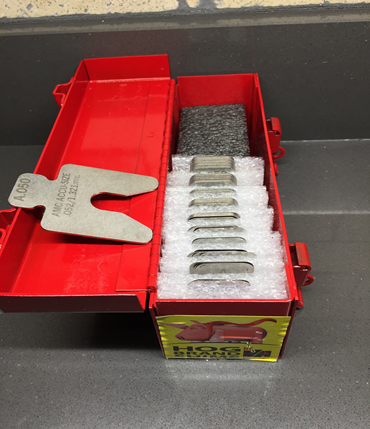The Dos And Don’ts Of Proper Shim & Tool Storage

No-one disputes the importance of precision measuring equipment for shaft alignment, but the crucial role that shims play is often underestimated.
The appropriate choice of shim, the correct use of shims and the right storage methods for these parts are critical success factors in obtaining a precision machine alignment and ensuring that rotating machinery continues to do its job efficiently, reliably and cost-effectively.
To illustrate the point, let’s look at the problem of soft foot which occurs when there’s improper contact between a machine’s casing and the base plate that supports it. It’s a major cause of repeatability issues and alignment quality and can result in costly equipment and operational problems.
Many factors contribute to soft foot, including bent or deformed shims, cheap carbon steel shims that aren’t uniformly thick, the re-use of old shim stock and stock that hasn’t been stored correctly. Soft foot can be an expensive problem and it’s just not worth taking any chances when trying to minimise and control it – and that means shims have to be clean, flat and deburred.
Whilst there are many other situations involving shims other than soft foot, the principle remains the same. Treat and store shims properly in order to get the best outcome.
So when it comes to shims and tools, here are some crucial do’s and don’t’s.
DO:
- Always use new, clean shims. The old adage that you need to ‘spend to save’ is as true as ever when it comes to using shims and when you weigh up the cost of buying new ones versus the financial losses and operational downtime that would very likely result from using old and inappropriate shims, new will always be the most cost-effective option.
- Use shims that are correctly sized for the application. Choose the shim size that provides maximum contact between the foot and the base plate.
- Be aware of the position of the shim stacks relative to the hold-down bolts and ensure there is sufficient clearance between them. This is necessary to prevent damage to the stack or bolt threads and to avoid bending the shim which can induce soft foot.
- Use shims that are sized consistently and never combine multiple shim sizes in the same stack.
- Use flat shims.
- Use clean shims, with no dirt or debris.
- Use quality stainless steel shims. Carbon steel stock is unlikely to withstand the compression resulting from the machine’s mass and the clamping force of the hold-down bolts. And remember, never combine shims of different materials in the same stack.
- Use the minimum number of shims possible when you’re correcting soft foot.
DON’T:
- Use dirty, deformed shins
- Don’t treat your stock carelessly (eg throwing shims into a container with other items)
- Don’t store shims in a place where they can get dirty, bent, accumulate grime etc. A bent shim can actually bring about soft foot.
- Don’t store your components in a place where they may be subjected to environmental degradation.
- Don’t be tempted by cheaper prices or shortcuts just to make perceived short-term savings. The reality is that it will probably end up costing your operation more in the long-run.
- Don’t try to cut several shims in order to ‘step’ the shim thickness under a particular foot. It is much more difficult to reposition several shims each time you attempt to align the equipment precisely and correctly.
On a related matter, the storage of shims and precision measuring tools is another important consideration because that’s where some of the least attention is paid, but is where some costly mistakes or oversights are often made.
Storing your precision measuring equipment
Although measuring and shaft alignment devices are manufactured for operation in robust industrial environments, they are precision instruments and it’s imperative that they’re handled responsibly and with care. The mounting brackets can be damaged if they are subjected to rough treatment, which can cause internal friction (also known as hysteresis) in the indicators.
Shaft alignment tools also need to be stored correctly, ideally in their original cases so that they are well protected when not in use. They also require routine servicing and maintenance to ensure they are correctly calibrated to deliver optimal performance.
Optimal performance also comes from having the right equipment for the job and Perth-based technical equipment supply company, Nexxis, knows how important the proper choice, use and storage of shims and tools are for any operation that takes performance seriously.
